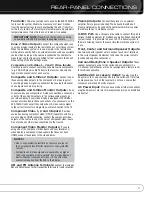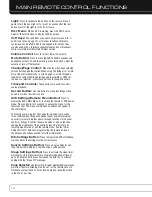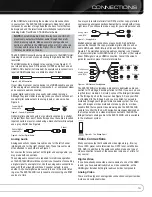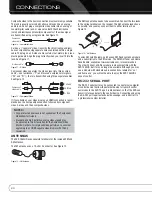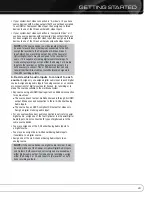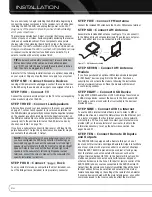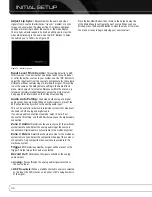
24
INSTALLATION
You are now ready to begin installing the AVR. Before beginning to
connect the various components to the receiver, turn off all devices,
including the AVR 7550HD, and unplug their power cords.
Don’t
plug in any of the power cords until you have finished making
all of your connections.
The receiver generates heat. Select a location that leaves several
inches of space on all sides. Avoid completely enclosing the receiver
inside an unventilated cabinet. Place components on separate
shelves rather than stacking them directly on top of the receiver.
Never block the AVR’s ventilation slots on the top and side panels.
Doing so could cause the AVR to overheat, with potentially serious
consequences.
Some shelf surface finishes are delicate. Try to
select a location with a sturdy surface finish.
TIP:
Label each cable before connecting it, to avoid mistakes.
Write a description of the cable on a blank adhesive label,
e.g., “DVD”, and fold the label around the cable about 6 inches
from the end to be plugged into the AVR.
Almost all of the following installation steps are optional, depending
on your system. Skip any step that does not apply to your system.
STEP ONE – Connect Source Devices
Leaving all AC power cords unplugged, connect the source devices
to the AVR using the audio and video inputs you assigned in Table 2.
STEP TWO – Connect TV
Connect the system-best video input on the TV to the corresponding
video monitor output on the AVR.
STEP THREE – Connect Loudspeakers
After you have placed your loudspeakers in the room as explained
on page 21, connect each speaker to its color-coded terminal on
the AVR. Maintain proper polarity by connecting the negative terminal
on the speaker (usually colored black) to the negative terminal on
the AVR (also colored black); and the positive terminal on the speaker
(usually red) to the positive terminal on the AVR (color varies by
channel; see Table 1 on page 18).
If you have a subwoofer, connect its line-level or LFE input to the
purple Subwoofer 1 Output. An optional second subwoofer may be
connected to the Subwoofer 2 Output.
NOTE:
If the subwoofer only has speaker-level inputs, after
you have configured the AVR using EzSet/EQ II technology as
described on page 29, connect the subwoofer’s left and right
speaker input terminals to the AVR’s Front Left and Front Right
Speaker Outputs, then connect the front left and right main
speakers to the subwoofer’s left and right speaker output
terminals. Consult the owner’s manual for the subwoofer for
specific installation instructions.
STEP FOUR – Connect
Dock
To enjoy content stored on a compatible iPod (not included), con-
nect The Bridge II dock (included) to its proprietary connector.
STEP FIVE – Connect FM Antenna
Connect the included FM antenna to the 75-ohm FM antenna terminal.
STEP SIX – Connect AM Antenna
Assemble the included AM antenna (see Figure 17) and connect it
to the AM and Ground antenna terminals. The antenna is not polar-
ized, and either lead may be connected to either terminal.
Figure 17 – AM Antenna Assembly
STEP SEVEN – Connect XM Antenna
Module
If you have purchased an optional XM antenna module designed
for XM Ready
®
devices, plug it into the XM jack. Purchase a
subscription and activate the module, following the instructions
posted at www.xmradio.com. Place the module within view of
a south-facing window.
STEP EIGHT – Connect USB Device
To play MP3 or WMA audio files or JPEG still-image files stored on
a USB storage device, connect the device to the front-panel USB
Port, using a cable or connector that is attached to the device or
provided by you.
STEP NINE – Connect AVR to Internet
To use the AVR’s internal Internet Radio tuner to listen to MP3 or
WMA audio streams, connect the Network Jack to the Ethernet port
on a router or modem that has Internet access, a home network,
or directly to a PC. You may need to contact your Internet service
provider (ISP), or the manufacturer of your router, to obtain the
information necessary to set up the network connection. See
pages 36 and 37.
STEP TEN – Connect Remote IR Inputs
and Outputs
The AVR 7550HD is equipped with a Remote IR Input, a Zone 2
Input and both full-carrier and stripped Remote IR Outputs to facilitate
use of your system with a remote control in a variety of situations.
When the AVR 7550HD is placed inside a cabinet or facing away
from the listener, connect an external IR receiver, such as the
optional Harman Kardon HE 1000, to the Remote IR Input jack. For
multizone operation, connect an optional IR receiver, keypad or
other control device to the Zone 2 IR Input for remote control of the
AVR 7550HD (and any sources connected to the AVR’s Remote IR
Output) from the remote zone. Signals transmitted through the Zone 2
IR Input will control source selection and volume for the main or
remote zone, depending on the setting of the remote’s Zone Selector.
If a source device is shared with the main listening area, any control
commands issued to that source will also affect the main room.
AVR 7550HD OM.qxd 2/25/09 11:52 AM Page 24


